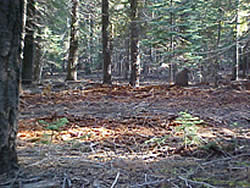
National Fire Plan Success Story
Huckleberry Fuels Reduction RAC Project
High Sierra District, Sierra National Forest
January 2005

An area in the Huckleberry project area before treatment.
The Huckleberry Fuels Reduction Project on the High Sierra Ranger District of the Sierra National Forest was initiated by a request from the Huntington Lake Association. They saw a need to deal with the reduction of ladder fuels, overgrown brush, and removal of large woody debris from around the recreation residences, which would create a defensible space in the event of a wildfire.
The Huckleberry Tract is grouping of 60 summer recreation residences on Huntington Lake in a true fir forest that is dominated by large overstory red fir and an understory of white fir. Residual dead and down fuels from past hazard tree activities consist mainly of coarse woody debris in the form of large red fir logs with pockets of white fir and brush in the understory. Many of the large old red fir trees average over three hundred years in age have started to decay and contribute to a hazardous condition; such trees were dropped within the tract to prevent damages to the cabins, which resulted in an excessive fuel load of large dry logs.
The Huckleberry fuels project was seen as an opportunity to create defensible space within the tract, improve forest health by removing the competing understory, and improve the working relationship between the Forest Service and the Huntington Lake Association. The projects activities included limbing up overstory trees, thinning out the understory, and chipping or hauling the slash to an off site location to be burned. This project allowed the residences to become involved as little or as much as they wanted in the protection of their own tracts. Many residences took the opportunity to thin out the small trees and save the ones they felt were important. The residences took the initiative to chip the resulting slash, which reduced the overall cost of the project.
Partners in the project included the Huckleberry Tract Association and the Huntington Lake Association. They were helpful in formulating a feasible project with limited dollars. They supported the project through the Secure Rural Schools and Community Self Determination Act Resource Advisory Committee (RAC) process to receive RAC dollars. These funds were used to offset the necessary appropriated dollars necessary to remove the decaying large logs from the tract. In the end, 53 out of 60 recreation residences thinned their own tracts, 110 additional common area acres in the tract were thinned to create defensible space, and 200 tons of decaying red fir logs was removed from the tract.
Some unique obstacles were encountered when working in this cabin tract. Water lines were only 3-6 inches under the soil surface and had to be fully flagged and avoided by equipment. Improvements around the cabins included fences, rock walls, standpipes and low clearance power lines that proved to interesting obstacles to avoid when loading and hauling the cull logs. Most roads within the tract are only a pickup truck width in size and maneuverability for the large equipment was a challenge. This was a very labor-intensive project due to limited maneuverability of equipment, all understory thinned trees had to be pulled to the road for chipping. Work in the tract was concurrent with the height of the summer use season and most cabins were occupied at the time when the work was in full swing. Contract specifications handled work hours, and most cabin owners were very glad to see the work being completed.
Contact: Carolyn Ballard, cballard @fs.fed.us, (559) 855-5355 x3354.